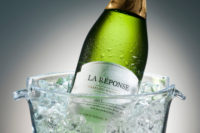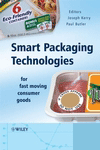CoverStory: Beverage Breakthroughs - Case Study
Beverage Breakthroughs: Creating lighter champagne bottles
Verallia uses simulation and optimization to help reduce bottle weight while preventing breakage.

Figure 1: This simulation of internal burst pressure for a hard-cider bottle using Abaqus FEA shows application of carbonation pressure loading and boundary conditions to model.

Bottle shapes are closely associated with specific beverages or brands, so changing a bottle's shape to reduce weight and materials treads into sensitive territory.

As bottles move from the glass-making mold to the bottling assembly line and then to the store shelf, they are at risk for possible chance of breakage.



When Dom Pérignon—French Benedictine monk and winemaker—was asked to look into why sparkling wine bottles were unexpectedly bursting in the cellars of his abbey in northern France three hundred years ago, he decided to investigate the bubbles. Fermentation, it turns out, continued after the beverage was bottled, producing additional carbonation and increasing pressure. By experimenting, so the story goes, Pérignon was able to control the refermentation process and reduce breakage and loss of the bottles’ contents.
Today, research engineers working for Verallia (www.verallia.com) at Saint-Gobain’s Research Center, near Paris, take a different tack to ensure there is no breakage: They analyze the bottles, not the bubbly. Xavier Brajer, a mechanical engineer responsible for the 15-person Mechanics of Materials Group in the company’s R&D department, leads these efforts. Central to the group’s analyses are initiatives—from the government, wine and beverage industry, and Saint-Gobain itself—to reduce the quantity of raw materials used in the bottle-making process. “In order to reduce our impact on the environment, we want to minimize the materials and energy used,” says Brajer, “and at the same time guarantee that the bottles have mechanical properties that will maximize their lifetime.”
Glass bottles are made from four readily available sources: silica or sand, soda ash, limestone and cullet (recycled glass). An average empty 750ml wine bottle weighs about 500 grams (17.6 ounces), accounting for about 30 to 40% of the bottle’s weight when full. A champagne bottle weighs about twice that amount. The sparkling beverage’s heavier, thicker-walled container is required because of the pressures produced by its carbonation: champagne produces the highest gas pressure of any beverage, which creates internal stress on the glass that needs to be considered when designing lighter bottles.
Despite the fact that beverage containers come in an almost unending variety of shapes, sizes, and colors, the profile of a champagne bottle is easily recognizable from across the room. Even the heft of the container is part of its perceived quality. Bottle shapes are closely associated with specific beverages or brands, so changing a bottle’s shape to reduce weight and materials treads into sensitive territory. When it comes to making these changes, Brajer and his R&D team consider the subjective aesthetic factors while relying on objective engineering tools.
“We start with a CAD model of the bottle shape that has been drawn by Verallia’s design department, in agreement with the customer,” says Brajer. “Then as we try and reduce the weight of the bottle, we use Abaqus finite element analysis (FEA) to simulate stresses and couple that with Isight software to optimize the geometry so that the container will withstand those stresses without breaking.”
Saint-Gobain has been using Abaqus, the SIMULIA brand for realistic simulation from Dassault Systèmes, for about 15 years, and started using Isight (also from SIMULIA) for automated and integrated simulation process flows about two years ago.
In a recent optimization analysis, the Saint-Gobain research team tested a lightweight design for a hard-cider bottle. Like champagne, this carbonated alcoholic drink creates internal pressure loading that is most likely to rupture the bottle at its weakest point—the bottom. So while trying to reduce the overall amount of material, it is on this region that Brajer and his team focused their engineering analysis, looking to maintain its mechanical resistance and strength.
The team started the pressure analysis by first creating a model of a reference bottle in Abaqus: A 2D model utilizing glass’ basic material characteristics was used to take advantage of the bottle’s axisymmetric geometry and save computing time (Figure 1). They then meshed the model and applied boundary conditions and loads. To optimize the geometric parameters (in this case nine, but sometimes more) that were used to describe the bottle’s bottom—such as internal and external shape, curvature, and a number of different radii—Abaqus was coupled with Isight. This allowed the team to automate the simulation workflow and systematically make changes in the parameters, calculate stresses for each profile, and ultimately determine minimal stress and optimal bottle shape. “In the case of the hard-cider bottle, we were able to reduce weight by 10 percent and stress on the critical bottom region by about 17 percent,” says Brajer. “In the past, it might have taken us a week to run the 100 simulations needed for this optimization. But now with an iterative looped process, it only takes about an hour.”
With the help of Verallia’s technical teams, physical testing was also utilized to complement simulation. “How we use testing may change in the future,” he adds, “because once we have calculations that validate the tests, design engineers will trust the virtual optimization process.”
Internal loading pressure is one of the most common causes of breakage for carbonated beverage containers, but it is far from the only one. As bottles move from the glass-making mold to the bottling assembly line and then to the store shelf, they are subjected to a variety of loading scenarios including thermal stress, impact, squeezing and compression and possible chance of breakage.
So while the pressure analysis was the first optimization study that the engineering team conducted, they intend to use a similar process—and the same software tools—to investigate the other ways that bottles break.
This design strategy is critically important today given the need to reduce CO2 emissions from manufacturing processes. “Our goal is to use less energy to produce each bottle,” Brajer says. “If we reduce raw materials, we reduce the energy needed to process those materials and to melt and form the glass. The amount of CO2 created in the process, in turn, is directly linked to the energy and raw materials usage.”
Given the quantities of bottled beverages and food consumed worldwide, the carbon footprint for bottle-making is worth addressing. Verallia, Saint-Gobain’s Packaging Sector, is the second largest glass bottle and jar manufacturer in the world—with a yearly production of roughly 25 billion containers.
Looking for a reprint of this article?
From high-res PDFs to custom plaques, order your copy today!









